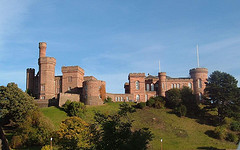1. Paco has been willing to see Loch Ness
After a very exciting journey, Paco has nearly arrived in Inverness, in the Scottish Highlands. Since he got on the train in Edinburgh, he has been reading about the area. Although the region covers about a quarter of Britain's land surface, very few people live there, and most of them are farmers. Some of the people still speak Gaelic, the ancient Celtic language of Scotland.
There are huge areas of land without any roads, where nobody lives but animals and plants. There are mountains with many sheep, wild deer and a lot of fish. The golden Eagle is a rare species that lives in the area too.
Inverness is the only city in the Scottish Highlands. As you may already know, for centuries, the inhabitants of Scotland have been building castles and fortifications of different kinds. Although many have disappeared, there are still a lot of them. Therefore the castle in Inverness is one of the most popular places in the city, together with St. Andrew's Cathedral or the Old High Church, which is the oldest church in the area. And near Inverness, you have the famous Loch Ness.
Paco has been looking through the window all the way from Edinburgh. He's amazed by the beautiful countryside: mountains, lochs (or lakes) and valleys. He's looking forward to visiting Loch Ness, and maybe seeing the famous monster, Nessie. Many people have claimed to see the monster but, obviously, there is no proof of this. It is supposed to be a large animal with a long narrow neck that is hidden under the water most of the time. There are many legends and stories about this, and it is not surprising, since the Loch is very deep and the water is dark. This way the mystery continues.
 |
 |
 |
| By ethan.crowley, C. Commons |
By conner395, C. Commons |
By g.naharro, C. Commons |
Verdadero Falso
Verdadero Falso
Verdadero Falso
Verdadero Falso
The structure of Present Perfect Continuous is very simple. And literal translation into Spanish is normally possible.
| SUBJECT + HAVE/HAS + BEEN + -ING FORM |
Remember the word 'continuous' always suggests an -ing form!
The Present Perfect Continuous is used:
- To emphasize the duration of an action that began in the past and continues to now.
- To express an action that began in the past and is still in progress (it's unfinished).
Both the Present Perfect Simple (that we have seen in topic 2) and the Present Perfect Continuous can emphasize the duration of a time period that began in the past and continues to now, but if the verb expresses no action (a state or condition), then the Present Perfect Continuous is NOT used. For example, the verbs 'to know' or 'to be'.
Complete the negative and interrogative structures:
| NEGATIVE | SUBJECT + __________ + BEEN + -ING FORM |
| INTERROGATIVE |
__________ + SUBJECT + __________ + -ING FORM ? |
Remember the rules when adding -ing to a verb:
- Normally just add -ing: work - working.
- If the verb ends in -e, eliminate it before adding -ing: live - living.
- If the verb ends in consonant + vowel + consonant, double the consonant: stop - stopping.
- If the verb ends in -y, DON'T CHANGE ANYTHING!: study - studying.